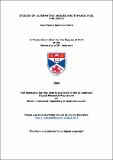Files in this item
Studies of alternatives anodes and ethanol fuel for SOFCs
Item metadata
| dc.contributor.advisor | Irvine, John T. S. | |
| dc.contributor.author | Corre, Gaël Pierre Germain | |
| dc.coverage.spatial | 167 | en_US |
| dc.date.accessioned | 2009-12-23T16:42:00Z | |
| dc.date.available | 2009-12-23T16:42:00Z | |
| dc.date.issued | 2009-11-30 | |
| dc.identifier | uk.bl.ethos.552310 | |
| dc.identifier.uri | https://hdl.handle.net/10023/841 | |
| dc.description.abstract | This thesis explores the development of efficient engineered composite alternative anodes and the use of ethanol as a fuel for Solid Oxide Fuel Cells. SOFCs can in theory operate with fuels other than hydrogen. However, this requires the design of efficient alternative anode material that do not catalyze carbon formation and that are tolerant to redox cycles. An innovative concept has been developed that relies on the impregnation of perovskites into porous YSZ structures to form the anode functional layer. Catalysts are added to provide sufficient catalytic activity. Cells with anodes containing LSCM and Ce/Pd have displayed excellent performance. At 800°C, and with a 65 μm thick electrolyte, the power outputs were above 1W/cm² in humidified hydrogen and 0.7 W/cm² in humidified methane. These electrodes have shown the ability to reduce CO₂ electrochemically with an efficiency that is similar to that which can be achieved for H₂O electrolysis and the anodes could operate on pure CO₂. The importance of incorporating an efficient catalyst was demonstrated. The use of 0.5 wt% of Pd is sufficient to dramatically improve the performance in such electrodes. The microstructure of impregnated LSCM-YSZ composites plays an important role in the high performance obtained. A layer of LSCM nanoparticles covering the YSZ is formed upon reduction, offering a great surface area for electrochemical reactions. The fabrication method presented in this thesis is a powerful tool for designing microstructures in situ. Among the various fuels under consideration for SOFCs, ethanol offers outstanding advantages. Half cell measurements have been performed to characterize the performance of different types of anodes when operated on ethanol/steam mixtures. Steady performance was achieved on LSCM-CGO anodes. Carbon deposits from gas phase reactions have been evidenced and were found to be responsible for the performance enhancement when the cell is operated in diluted ethanol as compared to hydrogen. At high steam content, polarization resistances of LSCM-CGO-YSZ anodes in ethanol/ steam mixtures were shown to be below 0.3 Ω.cm² at 950°C. | en_US |
| dc.language.iso | en | en_US |
| dc.publisher | University of St Andrews | |
| dc.subject | SOFC | en_US |
| dc.subject | Alternative anodes | en_US |
| dc.subject | Direct methane | en_US |
| dc.subject | Ethanol | en_US |
| dc.subject | Solid oxide fuel cells | en_US |
| dc.subject.lcc | TK2933.S65C7 | |
| dc.subject.lcsh | Solid oxide fuel cells | en |
| dc.subject.lcsh | Anodes--Materials | en |
| dc.subject.lcsh | Ethanol as fuel | en |
| dc.title | Studies of alternatives anodes and ethanol fuel for SOFCs | en_US |
| dc.type | Thesis | en_US |
| dc.contributor.sponsor | SUPERGEN | en_US |
| dc.contributor.sponsor | Office for Nuclear Regulation (ONR) | en_US |
| dc.type.qualificationlevel | Doctoral | en_US |
| dc.type.qualificationname | PhD Doctor of Philosophy | en_US |
| dc.publisher.institution | The University of St Andrews | en_US |
This item appears in the following Collection(s)
Items in the St Andrews Research Repository are protected by copyright, with all rights reserved, unless otherwise indicated.

